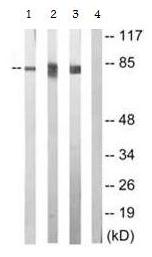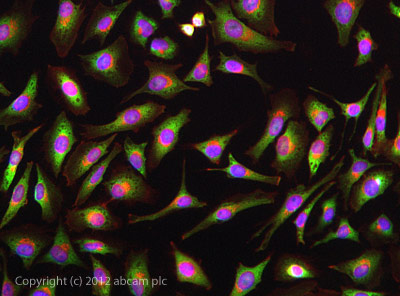
All lanes : Anti-PKC epsilon (phospho S729) antibody (ab63387) at 1/500 dilutionLane 1 : HeLa cells treated with PMA (125ng/ml, 30mins) at 30 µgLane 2 : Jurkat cells treated eith PMA (125ng/ml, 30mins) at 30 µgLane 3 : NIH/3T3 cells treated with PMA (125ng/ml, 30mins) at 30 µgLane 4 : NIH/3T3 cells treated with syntesized peptide (125ng/ml, 30mins) at 10 µg
![PKC epsilon was immunoprecipitated using 0.5mg Hela whole cell extract, 5µg of Rabbit polyclonal to PKC epsilon and 50µl of protein G magnetic beads (+). No antibody was added to the control (-). The antibody was incubated under agitation with Protein G beads for 10min, Hela whole cell extract lysate diluted in RIPA buffer was added to each sample and incubated for a further 10min under agitation.Proteins were eluted by addition of 40µl SDS loading buffer and incubated for 10min at 70oC; 10µl of each sample was separated on a SDS PAGE gel, transferred to a nitrocellulose membrane, blocked with 5% BSA and probed with ab63387.Secondary: Mouse monoclonal [SB62a] Secondary Antibody to Rabbit IgG light chain (HRP) (ab99697).Band: 84kDa; PKC epsilon](http://www.bioprodhub.com/system/product_images/ab_products/2/sub_4/12590_PKC-epsilon-Primary-antibodies-ab63387-2.jpg)
PKC epsilon was immunoprecipitated using 0.5mg Hela whole cell extract, 5µg of Rabbit polyclonal to PKC epsilon and 50µl of protein G magnetic beads (+). No antibody was added to the control (-). The antibody was incubated under agitation with Protein G beads for 10min, Hela whole cell extract lysate diluted in RIPA buffer was added to each sample and incubated for a further 10min under agitation.Proteins were eluted by addition of 40µl SDS loading buffer and incubated for 10min at 70oC; 10µl of each sample was separated on a SDS PAGE gel, transferred to a nitrocellulose membrane, blocked with 5% BSA and probed with ab63387.Secondary: Mouse monoclonal [SB62a] Secondary Antibody to Rabbit IgG light chain (HRP) (ab99697).Band: 84kDa; PKC epsilon

ICC/IF image of ab63387 stained HeLa cells. The cells were 4% formaldehyde fixed (10 min) and then incubated in 1%BSA / 10% normal goat serum / 0.3M glycine in 0.1% PBS-Tween for 1h to permeabilise the cells and block non-specific protein-protein interactions. The cells were then incubated with the antibody ab63387 at 5µg/ml overnight at +4°C. The secondary antibody (green) was a goat anti-rabbit DyLight® 488 (ab96899) IgG (H+L) used at a 1/1000 dilution for 1h. Alexa Fluor® 594 WGA was used to label plasma membranes (red) at a 1/200 dilution for 1h. DAPI was used to stain the cell nuclei (blue) at a concentration of 1.43µM.

![PKC epsilon was immunoprecipitated using 0.5mg Hela whole cell extract, 5µg of Rabbit polyclonal to PKC epsilon and 50µl of protein G magnetic beads (+). No antibody was added to the control (-). The antibody was incubated under agitation with Protein G beads for 10min, Hela whole cell extract lysate diluted in RIPA buffer was added to each sample and incubated for a further 10min under agitation.Proteins were eluted by addition of 40µl SDS loading buffer and incubated for 10min at 70oC; 10µl of each sample was separated on a SDS PAGE gel, transferred to a nitrocellulose membrane, blocked with 5% BSA and probed with ab63387.Secondary: Mouse monoclonal [SB62a] Secondary Antibody to Rabbit IgG light chain (HRP) (ab99697).Band: 84kDa; PKC epsilon](http://www.bioprodhub.com/system/product_images/ab_products/2/sub_4/12590_PKC-epsilon-Primary-antibodies-ab63387-2.jpg)
